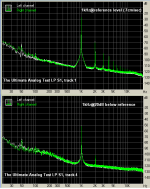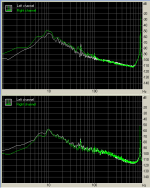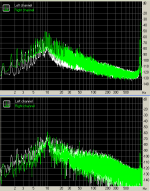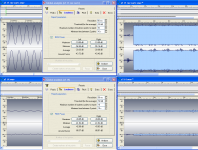As to skin effect, it's an eddy current loss mechanism, and the loss appears as increased coil resistance of a conductor in a way which is frequency dependent. 50 gauge wire or finer used in cart coils quite possibly shows resistive variation over the 3+ decades of audioband. But seldom does a circuit rely on precise coil resistance, except for TI loaded preamps like Aurak.
Eddy current loss mechanisms are also likely present in the moving armature pole-piece if it is conductive, or the elephant is really the coil core.
A cartridge might be thought of as transformer where the primary is mechanical, and the source of flux changes is a moving armature. Same core non-linear loss mechanisms apply as audio transformers, and several are slew-rate (frequency-level) dependent.
One could wind a small seperate coil, or an overwinding, and treat it as a primary winding. That might allow exploration of the coil/core behaviours in a more flexible way than relying on mechanical playback because of limited test records. As 1audio says.
As to harmonic distortion in vinyl playback, it is only pronounced at high levels that seldom occur in normal playback. Contrary to common-wisdom, distortion (even pinch effect) is a geometric function of level and rotational velocity (location on record), and of tracking angle error - not of frequency. It increases with frequency only because of RIAA pre-emphasis. Baerwald, 1941.
Distortion shows up prominently in sweep and trackability tests because those tests are mostly on the warm side of recorded levels. But yes, distortion is a certainty as to a geometric cause of f response varying with level, mostly following the RIAA emphasis curve.
LD
Eddy current loss mechanisms are also likely present in the moving armature pole-piece if it is conductive, or the elephant is really the coil core.
A cartridge might be thought of as transformer where the primary is mechanical, and the source of flux changes is a moving armature. Same core non-linear loss mechanisms apply as audio transformers, and several are slew-rate (frequency-level) dependent.
One could wind a small seperate coil, or an overwinding, and treat it as a primary winding. That might allow exploration of the coil/core behaviours in a more flexible way than relying on mechanical playback because of limited test records. As 1audio says.
As to harmonic distortion in vinyl playback, it is only pronounced at high levels that seldom occur in normal playback. Contrary to common-wisdom, distortion (even pinch effect) is a geometric function of level and rotational velocity (location on record), and of tracking angle error - not of frequency. It increases with frequency only because of RIAA pre-emphasis. Baerwald, 1941.
Distortion shows up prominently in sweep and trackability tests because those tests are mostly on the warm side of recorded levels. But yes, distortion is a certainty as to a geometric cause of f response varying with level, mostly following the RIAA emphasis curve.
LD
Magnetic non-linearities have the possibility of a frequency selective distortion, add in RIAA equalisation and you end up with nothing like simple compressionGenerally, distortion caused by nonlinearity reduces the perception of dynamics, often in a very pronounced way....
So after reading all this stuff, Did anyone else change their RIAA eq to match their cartridge?
I did this in 1988 or 89 the LF353 is dated 04-86 I used Brothers in Arms as the CD / LP source material.
I did this in 1988 or 89 the LF353 is dated 04-86 I used Brothers in Arms as the CD / LP source material.
Last edited:
It is a slippery slope if it is to be coupled with the dynamics of the cartridge and I haven’t coupled it with that.Yes, increased distortion changes perceived loudness, but to couple that with the perception of dynamics is a very slippery slope.
But regarding the perception of dynamics (and the dynamics of vinyl playback), harmonic distortion makes the sound perceived louder. It is the inharmonic components that don’t couple with perceived higher loudness.
And yes, there is also inharmonics (IMD) produced, although not that high in amplitude as the harmonic components.
Regarding eddy current losses or any losses tagged as RLT in the cartridge model, looking at the LCR meter readings, you will notice reading the last column (Rs) that the resistive component increases a lot with frequency with all the MM cartridges (with a slight peculiarity of the Shure), less so with the MI cartridge (AKG) and not at all with the MC cartridge (Denon)
George
Attachments
So after reading all this stuff, Did anyone else change their RIAA eq to match their cartridge?
.
More I changed the phono stage to hammer the cartridge into submission 🙂
It is a slippery slope if it is to be coupled with the dynamics of the cartridge and I haven’t coupled it with that.
But regarding the perception of dynamics (and the dynamics of vinyl playback), harmonic distortion makes the sound perceived louder.
George
George in your plot the difference in fundamental is more than 20dB. Was this done carefully enough to make note of that (seems to be several dB)?
I haven’t done any interventions. It is what it came out (everything was done in the same way, with the same equipment, all in one go)
You are right.
The difference between the 1kHz FFT peaks is 23.4dB instead of 20.
I had to look. Here is what I noticed.
The difference in height between the low level knee at 700Hz and the 1kHz peak is 79.43db for the FFT of track1 and 60.54dB for the FFT of track 4.
So we have an actual difference of 18.9dB between the two 1kHz FFT peaks. This is very close to 20dB for vinyl standards.
The extra height of the 1kHz FFT peak of the hotter track 1 is due to the raised FFT floor. Sounds familiar? 😀
George
You are right.
The difference between the 1kHz FFT peaks is 23.4dB instead of 20.
I had to look. Here is what I noticed.
The difference in height between the low level knee at 700Hz and the 1kHz peak is 79.43db for the FFT of track1 and 60.54dB for the FFT of track 4.
So we have an actual difference of 18.9dB between the two 1kHz FFT peaks. This is very close to 20dB for vinyl standards.
The extra height of the 1kHz FFT peak of the hotter track 1 is due to the raised FFT floor. Sounds familiar? 😀
George
Attachments
I haven’t done any interventions. It is what it came out (everything was done in the same way, with the same equipment, all in one go)
You are right.
The extra height of the 1kHz FFT peak of the hotter track 1 is due to the raised FFT floor. Sounds familiar? 😀
George
Careful the floor represents the integrated noise in each bin, the signal is at one frequency so they should root sum square together not add.
it's hard sometimes to rationalize the rise in floor on some measurements because of issues like windowing leakage, etc. If the goal is to get frequency response with level measurements that are meaningful there are a lot of confounders. As I said in the past, when I ran the STR100 LP with a $400 MC and $15 Grado the differences (especially THD) were not striking.
Last edited:
Remember this isn't digital, and test tone frequency varies somewhat with time due to pitch shift from all causes. So to establish amplitude, one has to integrate bins adjacent to (and including) the one containing the peak, rather than taking the peak height, of course. If frequency resolution of the FFT is fine enough to make this an issue, as it seems to be.
Visually, it all looks plausible IMO.
LD
Visually, it all looks plausible IMO.
LD
I wonder if it would work to get a cheap pair of earbud headphones and remove the speaker. then place the speaker carefully on the platter, with the table unplugged, then place the needle on the speaker cone and test.
4.7uf (and 330 ohm resistor) at 32 ohms places the passband at just over 1khz
RIAA would be 3.3k and 0.47uf cap approximately
-40db @ 100 -20db @ 1khz and 0db > 10khz.
4.7uf (and 330 ohm resistor) at 32 ohms places the passband at just over 1khz
RIAA would be 3.3k and 0.47uf cap approximately
-40db @ 100 -20db @ 1khz and 0db > 10khz.
Last edited:
Ah yes, vinyl realities
Hotter recording excites the arm/cart resonance stronger.
The noise floor as seen on the lower resolution FFT is the connecting line between the eccentricity peaks as seen on the higher resolution FFT.
The eccentricity peaks are riding over the arm/cart resonance profile.
On the second attachment (right side) it is seen that the subsonic signal is stronger
George
Hotter recording excites the arm/cart resonance stronger.
The noise floor as seen on the lower resolution FFT is the connecting line between the eccentricity peaks as seen on the higher resolution FFT.
The eccentricity peaks are riding over the arm/cart resonance profile.
On the second attachment (right side) it is seen that the subsonic signal is stronger
George
Attachments
I any case it's still root sum squared and since the tone is almost perfectly centered the first adjacent bins (if all the bins are displayed) are 30dB or so down which adds virtually nothing to the fundamental. There is a lot of detailed methodology to agree on if this wants to be a precision exercise.
There is a lot of detailed methodology to agree on if this wants to be a precision exercise.
That’s true and I accept that I am not the one with whom you can properly discuss the FFT subtleties.
But for this particular case, what is shown on the FFT reflects the reality of the playback signal. The signal is noisier due to increased infrasonic content .
George
That’s true and I accept that I am not the one with whom you can properly discuss the FFT subtleties.
I was actually addressing Lucky. Consider a high enough resolution FFT where there are bins in between even the .55Hz FM side bands add to that some slow frequency wander and it can get complicated.
RMAA is displaying absolute FFT levels in an inaccurate way and is not meant to be used as such, according to Liadov the designer of RMAA.George in your plot the difference in fundamental is more than 20dB. Was this done carefully enough to make note of that (seems to be several dB)?
You can compare shapes and different distortion levels of spectra, but not the absolute levels.
However RMAA enables to shift spectra up and down, so when you know that there is a level difference of 20dB between 2 recordings, you can manipulate one of the two spectra to adjust accordingly.
Hans
Last edited:
However RMAA enables to shift spectra up and down, so when you know that there is a level difference of 20dB between 2 recordings, you can manipulate one of the two spectra to adjust accordingly.
So then its useless for this purpose because it's the difference we want we can't make that assumption.
I would expect the wire ac resistance to rise maybe tenfold due to the proximity effect, but the > x100 being measured must have something else going onRegarding eddy current losses or any losses tagged as RLT in the cartridge model, looking at the LCR meter readings, you will notice reading the last column (Rs) that the resistive component increases a lot with frequency with all the MM cartridges (with a slight peculiarity of the Shure), less so with the MI cartridge (AKG) and not at all with the MC cartridge (Denon)
George
What is the measurement level, LCR meters tend to test at far higher levels than normal operation?
So then its useless for this purpose because it's the difference we want we can't make that assumption.
I noticed this innacuracy several years ago and got this answer from Maxim Liadov.
A workaround with .wav files is to put two right or two leftchannels of exactly the same period as L and R channel in one recording before offering it to RMAA.
I lost access to the impedance measurements of the previous 5 days, together with anything I had saved the last 10-11 years on a 750GB HD.
I am totally pissed off
 😡
😡
George
I am totally pissed off
 😡
😡
George
Happened to me last week. The bigger fail was the backup didn't work. Lesson, back up often in separate places and check/test the restore function. Always learned in hindsight. I was going to transfer all the data to a new drive the next day but a head came loose and its gone. . .
- Status
- Not open for further replies.
- Home
- Source & Line
- Analogue Source
- Cartridge dynamic behaviour



